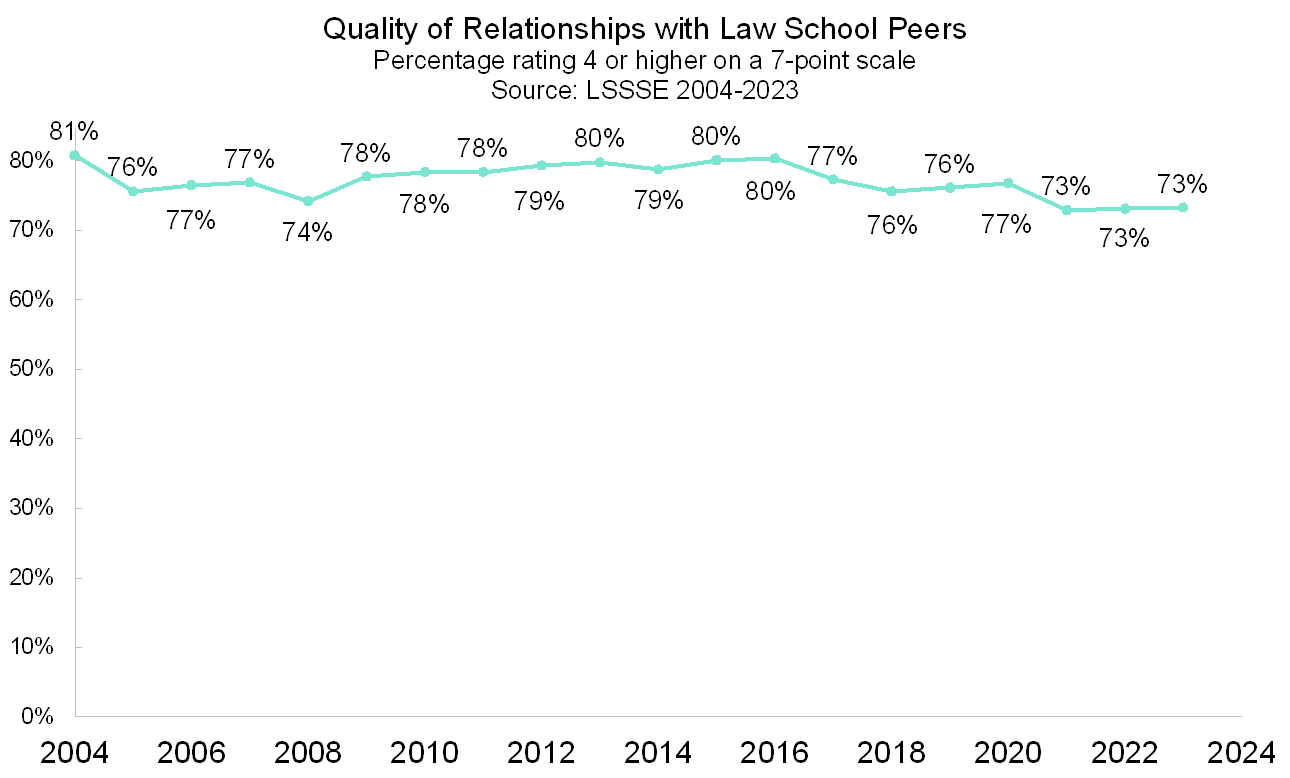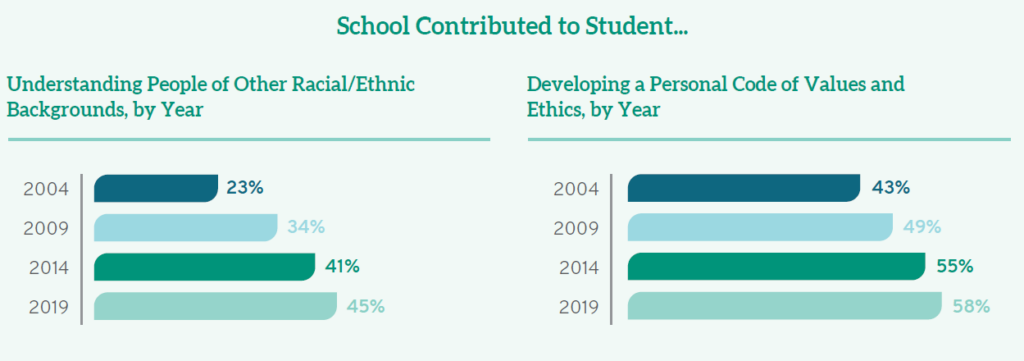A Long-Term Look at Relationships with Law School Peers, 2004-2023
A common misconception about law students is that their competition with each other for grades, jobs, and prestige creates a stressful and hostile law school environment. However, this is not the case for most law students who often find opportunities for support and friendship among their peers. Law students share common challenges and goals, and they can benefit from exchanging ideas and resources with each other. Many law schools also foster a culture of collegiality and mutual respect, where students are encouraged to help each other and celebrate each other's achievements. Rather than being a source of stress, peer relationships can be a source of resilience and well-being for law students. In fact, LSSSE data from 2023 show that only 38% of law students experienced quite a bit or very much stress or anxiety because of competition with peers. They are far more likely to be substantially stressed by academic performance (80% of students) and academic workload (79% of students).
Since the 2004 LSSSE inaugural survey, an average of 77% of law students have said that their overall relationships with other students are mostly positive (at least a 4 on a 7-point scale). This number has fluctuated over time, with 81% of students having mostly positive relationships in 2004 and 73% of students feeling similarly in 2023.

If we compare the percentage of students having an overall positive relationship with peers to the all-time LSSSE national average of 77%, we can see that the last several years have had slightly lower levels of peer satisfaction.

Although satisfaction with peer relationships was already on a somewhat downward trajectory before COVID-19, the notable decrease in relationship satisfaction during the 2020-2021 academic year may be largely driven by the decrease in relationship satisfaction among 1L students. In the spring of 2020 (largely before COVID-19 shutdowns started), 80% of 1L students were satisfied with their relationships with their fellow students. In the spring of 2021 after a year of huge disruptions in the law school environment including widespread online learning, only 72% of 1L students felt this way. However, 74% of 3L students were satisfied with their peer relationships in 2020 and again 74% of 3L students felt this way in 2021. Students who were introduced to law school in a time of necessary isolation were understandably somewhat less able to bond with their classmates. Orientation programs, study groups, moot courts, clinics, extracurriculars, and informal gatherings were either canceled, restricted, or moved online. These disruptions may have hindered the ability of 1L students to establish friendships and build rapport. Furthermore, online learning may have decreased the frequency and quality of interactions among students, as well as the sense of belonging and community that stems from being physically present in a shared space. Nevertheless, relationships among law students remained positive overall, showing that even the limitations of pandemic life did not prevent characteristically creative and resilient law students from forging relationships with each other. It will be interesting to examine how law students feel about their relationships with each other in future years now that life has largely returned to the pre-pandemic normal.
The Changing Landscape of Legal Education: Positive Learning Outcomes
Over the past fifteen years, LSSSE has documented dramatic changes in legal education. From 2004 to 2019, the changing landscape of law school was punctuated by increasing diversity among students, rising debt levels, relative consistency in job expectations, and improvements in various learning outcomes. In spite of many challenges, law students nevertheless report relatively constant positive levels of satisfaction with legal education overall. Our 2020 special report The Changing Landscape of Legal Education: A 15-Year LSSSE Retrospective shares longitudinal findings on select metrics as well as demographic differences within variables to catalog how legal education has changed over time. In this blog post, we will share how students have increased their achievement of selected learning outcomes from 2004 to 2019.
According to LSSSE data, law schools contributed to increases in a variety of perceived learning outcomes from 2004 to 2019; collectively, these point toward progress in terms of how students measure their own skills and likely in terms of actual practice-readiness of graduates. In 2004, only 23% of students saw their schools as doing “quite a bit” or “very much” to help them understand people of other racial and ethnic backgrounds; because of steady increases over the next fifteen years, especially between 2009 and 2014, almost half (45%) of students today see their schools as doing “quite a bit” or “very much” to prepare them to interact with racially diverse colleagues and clients.

In addition, schools have increased their emphasis on professional responsibility in the past fifteen years. While even in 2004 a full 43% of students saw their schools as doing “quite a bit” or “very much” to encourage them to develop a personal code of values and ethics, that number has now grown to 58%. Schools were already prioritizing complex problem solving fifteen years ago, and students see institutional support for this skill growing over time as well. While in 2004, 12% of students believed their law schools contributed “very much” to their ability to solve “complex real-world problems,” that percentage has doubled over fifteen years so that now almost a quarter (24%) of students agree. Law schools are also encouraging students to focus on developing career goals and aspirations. In 2004, almost a quarter (23%) of all law students saw their schools doing “very little” to contribute to their developing clearer career goals; by 2019 those statistics dropped to 14%. On the flip side, while only 11% saw their schools doing “very much” in this regard in 2004, that number has risen steadily, reaching 22% in 2014 and remaining there in 2019.

Looking at the past can help prepare us for our future. To learn more, you can read the entire Changing Landscape report here.


